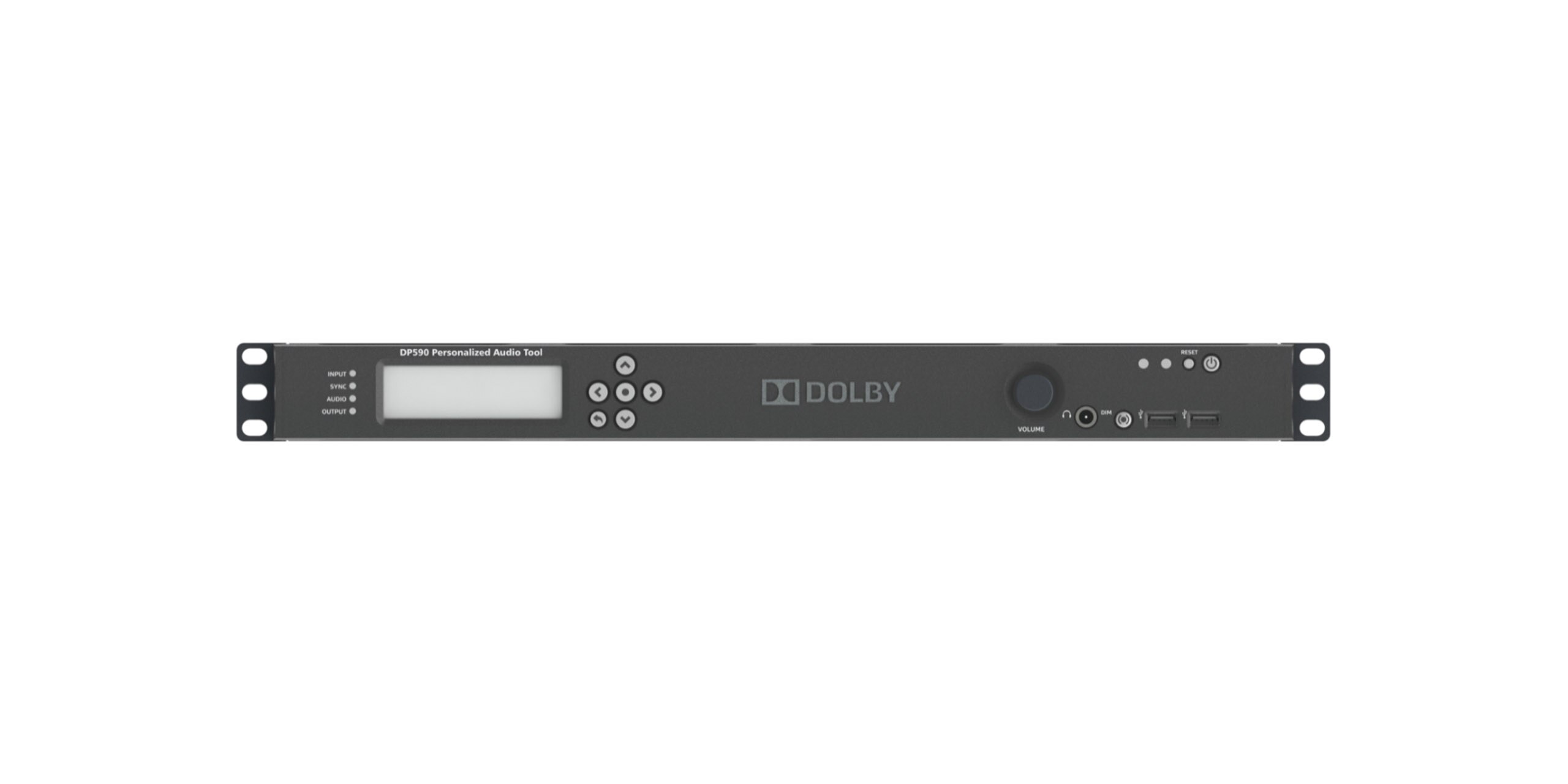
Dolby DP590 Broadcast Audio Object Authoring
The Dolby DP590 Broadcast Audio Object Authoring tool is a key element of Dolby’s industry-leading object-based audio authoring toolkit that assists broadcasters, live audio mixers, and engineers in the adoption and deployment of immersive audio for live events.
Dolby’s object-based audio (OBA) authoring toolkit for broadcast applications consists of the DP590 Broadcast Audio Object Authoring tool (DP590), the DP591 Audio Encoder (DP591), and the DP580 Professional Reference Decoder (DP580). This toolkit provides the ability to do immersive audio authoring, encoding, and monitoring.
The DP590 provides a user-friendly interface to give the audio engineer easy access to set up and deliver a new immersive audio experience as channel-based audio (e.g. 5.1.2, 5.1.4). It does this by ingesting audio groups from the mixing console and providing a simple way to create object audio presentations, including mapping sounds to locations in 3D space, and developing associated metadata. It also provides an easy way to monitor the changes to the immersive audio content that has been created, including emulating different speaker configurations.
The DP590 wraps around an audio mixing console as show in the diagram shown below. It enables audio engineers to define and monitor the various combinations of the audio elements that they wish to create. Each defined combination is referred to as a Presentation, and downstream decoders can be set to decode and render each presentation — for example, “5.1 English” — whenever this is required. The metadata used within the presentation is fully defined in the DP590 and is therefore under the control of the audio engineer. Presentations can be appropriately named for the production and may refer to languages, targeted delivery paths, or enhanced experiences as desired by the producers.
Simplified live production workflow
Technical benefits
- Supports the creation of the different presentations and the associated metadata required for immersive audio delivery.
- Provides local confidence monitoring of the presentations created for different playback environments without the need for additional equipment.
- Supports loudness measurement of the monitored presentation to ensure regulatory compliance.
- Provides proven design and reliability for installation in existing OB trucks.
- Interfaces with industry leading mixing consoles and provides external control of DP590 functionalities from existing mixing consoles thru GPIO using JNIOR device.
- Provides an easy to use user interface that simplifies the process of creating immersive audio for live events.
Business benefits
- Eliminates the need for broadcasters to make a major investment in new production capabilities to deliver compelling immersive audio entertainment experiences to the home and on mobile.
- Works with existing microphone configurations with limited modification needed to bring fans closer to the action. Allows broadcasters to deliver immersive audio for live events that leverages the growing number of Dolby Atmos enabled playback devices.
- Supports the transition to 4K/UHD/HDR with enhanced audio experiences while allowing these experience to get better over time as platforms and skills develop.
- Simplifies the workflow for live production of immersive audio.
- Gives producers and audio mixers the creative freedom to mix audio as desired to create the immersive audio experience that will pull fans into the action.
DP590 Specifications
Input / Output
SDI input
- Two auto detecting BNC female connectors, 75Ω, unbalanced
- Supports SD-SDI (SMPTE 259M-1998), 1.5 GB/s HD-SDI (SMPTE 292M-1998), 3.0 GB/s HD-SDI (SMPTE 424M-2008)
AES input or MADI input
One BNC female connector, unbalanced, 75Ω,
- AES: signal levels per AES-3id-1995 (SMPTE 276M)
- MADI: signal levels per AES-10id-2055
VREF input
One BNC female connector, unbalanced, 75Ω, support for video reference signal
SDI out
- Two auto detecting BNC female connectors, 75Ω, unbalanced
- Supports SD-SDI (SMPTE 259M-1998), 1.5 GB/s HD-SDI (SMPTE 292M-1998), 3.0 GB/s HD-SDI (SMPTE 424M-2008)
AES outputs
Four BNC female connectors, unbalanced, 75Ω, signal levels per AES-3id-1995 (SMPTE 276M)
MADI output
One BNC female connector, unbalanced, 75Ω, signal levels per AES-10id-2005
Headphone output
6.35 mm (1/4-inch) standard stereo headphone jack for confidence monitoring
Media Ethernet port
RJ45 connector for 1000Base-T Ethernet; not used
Control Ethernet port
RJ45 connector for 1000Base-T Ethernet; provides status and control through a web-based user interface
Audio processing
Input:
Up to 32 PCM channels at 48 kHz
Output:
Up to 32 PCM channels at 48 kHz
Loudness measurement
ITU-BS.1770-4 and EBU R-128
System management:
SNMP 1.2 support
Power specifications
- Power supply: Dual, hot-swappable from rear
- Input voltage range: 100–240 VAC
- Input frequency range: 50–60 Hz, autosensing
- Power consumption: 350 W
Physical
- Dimensions: 1-U rackmount: 44 × 483 × 394 mm (1.75 × 19 × 15.50 inches)
- Weight: Net: 6.5 kg (14.5 lb.)
Environmental
- Cooling: Front to rear airflow; Temperature-controlled fans
- Operating Temperature: 0°C–40°C (32°F–104°F)
- Storage Temperature: 0°C–40°C (32°F–104°F)
- Operating Humidity: 20%–80% relative humidity (noncondensing)
Regulatory Notices
North America:
UL, FCC, and CE compliant
Europe:
Complies with the European Union Directive 2002/95/EC on the restriction of the use of certain hazardous substances in electrical and electronic equipment (RoHs), as amended by Commission Decisions 2005/618/EC, 2005/717/ EC, 2005/747/EC (RoHs Directive), and WEEE
Broadcast Solutions
Look to Dolby for the comprehensive tools, content services, and solutions you need to create, distribute, and deliver the highest-quality audio and imaging content.
